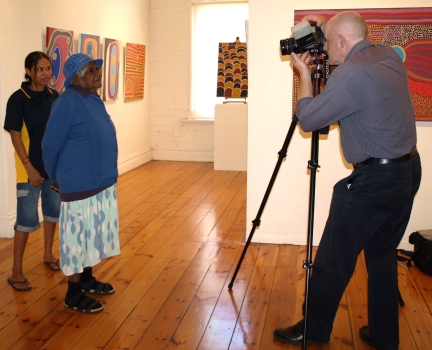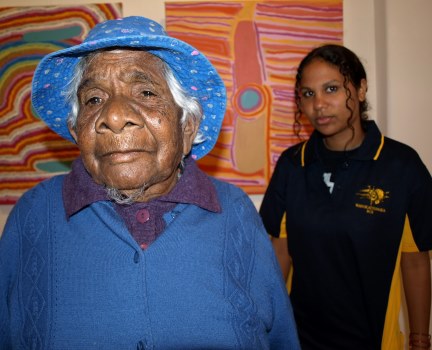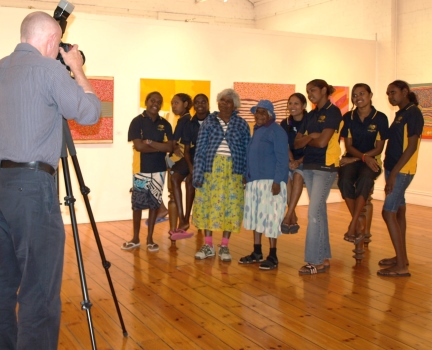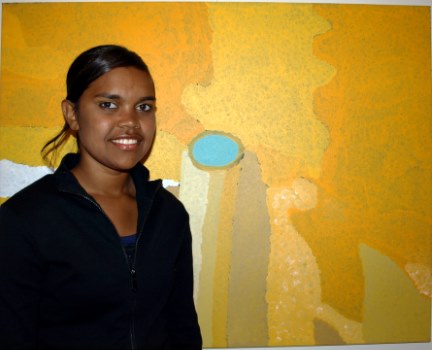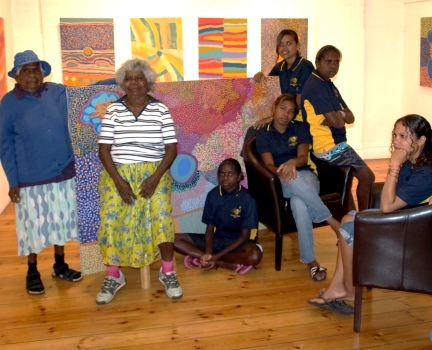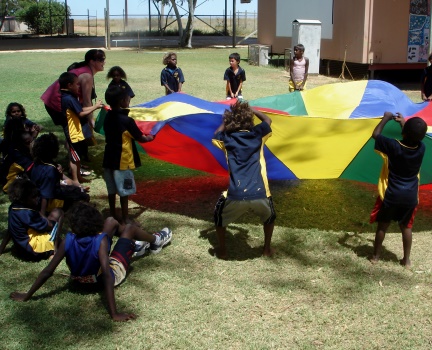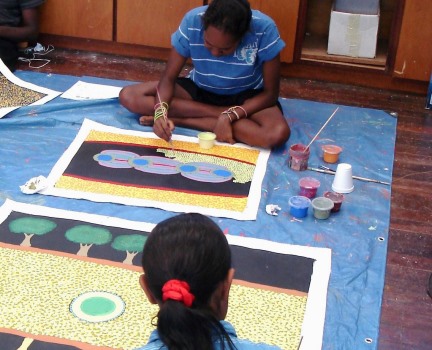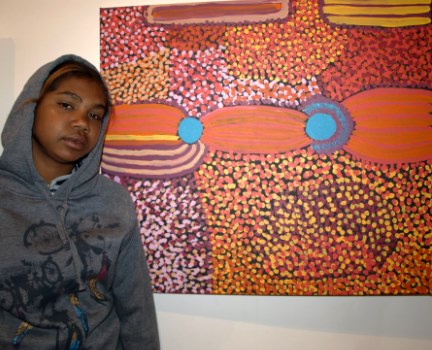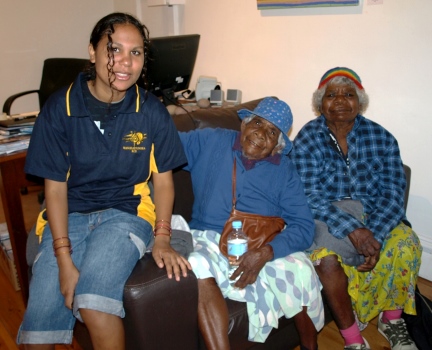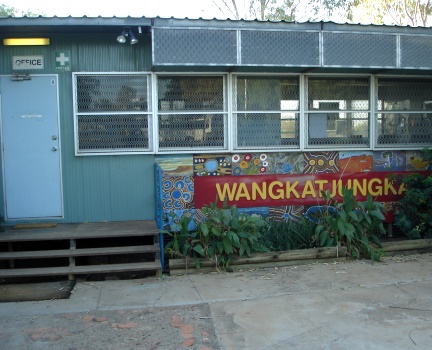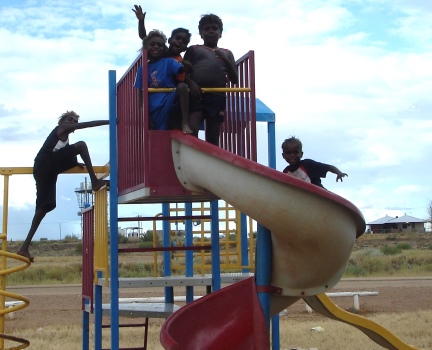The Wangkatjungka Remote School Mentors Project – Part 3
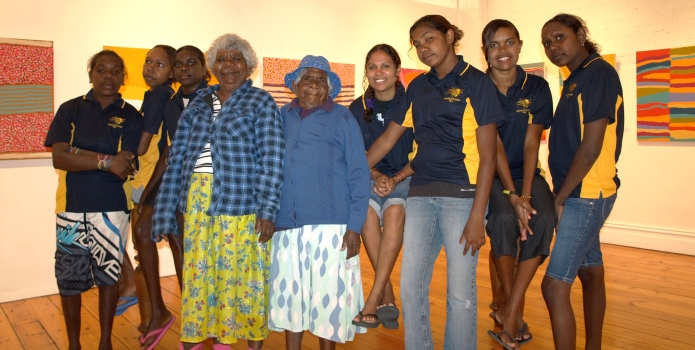

The Gallery Director’s Story – Ian Plunkett
In 2009 a project at Wangkatjungka Remote Community School brought the teenagers and elders together. The project boosted school attendance to unheard of levels as well as creating an exciting event at Japingka Gallery. Here is the story of that project told by Ian Plunkett.
Quick links: Part 1 | Part 2 | Part 3
The Community
Could you tell me where is Wangkatjungka?
Wangkatjungka is a small community to the south-east of Fitzroy Crossing. It is about 500 kms east of Broome in Western Australia. The community is near Christmas Creek. Sometimes people will still use that name, but the indigenous name is Wangkatjungka. The indigenous people living at Wangkajunga are Walmatjarri speaking people. It’s a small community sometimes with a couple of hundred people, a school and a few facilities.
How remote is it, how hard is it to get there?
I think it’s very remote. The official school name is Wangkatjungka Remote Community School. It is a bit off the beaten track, about 20 kms off the main highway. It’s not really on the way to anywhere else. You have to be planning to go there.
Project Background
How did the Wangkatjungka project come about?
We had been working with the elders up in the Wangkatjungka community for a few years. Japingka Gallery started as Desert Designs in the early 1980s. That venture was a collaboration with a Walmatjarri elder called Jimmy Pike. Some of his family are from around that community. The people living in and about Wangkatjungka are the extended clans that lived in the desert country neighbouring with Walmatjarri people . They’re relatives and extended clan members with related history and knowledge of the country.
There came a point where the community itself needed fresh art representation. They’d seen what was happening at Mangkaja, at Fitzroy Crossing with the arts. They approached us because of our long term relationship with Jimmy Pike. The community had seen how his career had grown. He’d become independent and world famous. That was why they approached us to represent their community. This is how we had been working with the elders for quite a few years.
David used to go up there a number of times each year. He would work in the community with the artists. He got to know some of the people in the town there. This included the Principal of the Wangkatjungka Remote Community School, Keith Spencer and his wife Catie.
One day David was having a conversation with Catie Spencer. The school had just built a patio to shade and protect it from the sun. The Principal’s wife thought it would be a good idea for the girls to decorate it in local and traditional patterns. She was describing what happened next.
The high school girls, fourteen to sixteen years of age, just drew love hearts and the like on the patio. She asked the girls, “Why are you doing these love hearts, why aren’t you doing traditional designs and stories?” All the girls said, “Well we don’t know them, we haven’t been out to the old people’s country. We just know this community and the store and all around here.”
The fact was they’d hardly been far from Wangkatjungka and the nearest towns like Fitzroy Crossing. They’d never seen their old family traditional lands. Their country is now so remote it’s difficult to get there even by four wheel drive. It’s really harsh country out on the Great Sandy Desert. It’s really remote, and no one lives out there now. All the people have moved away and they’re living in communities closer to settlements now.
That was a kind of revelation for the Principal’s wife. She mentioned it to David and said, “What’s happened here? It’s a bit sad that the stories and the culture are going.” After discussions they came up with the idea of putting the project together.
David was already working with the Wangkatjungka elders. It was proposed that there be formalised sessions where the elders would work with the young girls. They’d include the knowledge and painting skills and stories. The elders were keen to do it because they wanted to have that connection with the younger generation. They liked to think that the culture could be strong and be passed on.
Attendance Rates Soar
One of the things with the remote school is that it had quite a low attendance record. There were large numbers of students who weren’t coming regularly. There were attendance rates of twenty percent or less for some of the students. This is fairly normal for some of these remote schools.
After careful consultation the project was announced to the school. The students would have the chance to work with the elders, learn stories and paint alongside senior artists. If it all worked out well they would have an exhibition of their work down at Japingka Gallery in Fremantle. As most of them had never been to the city this was exciting. The project was an unparalleled success right from the outset.
Attendance rates at the school got it up over 80%. This continued even after the collaboration had finished. At that time it was a real success story.
Several times people told us why they thought this had worked so well. For these indigenous people to be involved you really need to be doing two things. You need to be teaching them how to survive in the western world. You also need to be giving them access to their culture and a real relevance to their daily lives. They really want to learn about their country, the traditions, the stories associated with these paintings.
What was set up was this regular painting school where the elders went in and David helped facilitate that. It was immediately apparent that these girls had outstanding visual acuity, a real talent at painting. In fact, as I was being sent images of some of the paintings being created, it was hard to tell which were done by the students and which by the elders. The students picked up the visual cues very quickly. Depending on which elder they were working with they were able to understand and to re-create that elder’s style. It was stunning.
The Timeframe
Over what time frame did this occur?
It was over six months. It went through the middle of the year with the exhibition in November. We were aiming to get the body of work together. The plan was for a few of the elders, the Principal and some of the Education Department people to sign off on it. In November the whole group would come down for the exhibition opening.
The Participants
How many people were involved?
There were seven of the girls in this first project. They were aged from fourteen to sixteen. There was the Principal and some teachers and people from the Education Department. You look at the photographs of the opening night and you can see it was a major success. It involved the whole community. While the girls were here they were phoning their excitement back to the people in Wangkatjungka. They were telling them what it was like in the big city. It was an amazing story.
Audience Response
How did the audiences respond?
The audience were staggered by the talent. You just have to look at the photographs of what was on the walls in the exhibition to see that these young people were so talented. It is a little bit worrying is that all this talent wasn’t being explored. It felt like it was being left fallow. No one seemed to be encouraging these girls to paint and use their skills. They hadn’t made their own connection to country until that point.
People here were absolutely staggered by the work, it was a sell out exhibition. They weren’t high prices of course because these are young students. It was their first exhibition. Nonetheless it was a lot of money for the girls who were just living in a remote community with no real income. It made a difference to their lives. It was so valuable to get recognition from art lovers and the general public. People they’d just met were saying, “This is brilliant. Gosh you’re talented and we’d like to buy your work.” I mean there’s nothing like that sort of affirmation. The girls really grew in a short period of time. They became more confident and were able to deal with the praise. They were getting lots of it.
Media Response
How did the media respond?
The media just saw it as a great story. It’s not something that happens very often so all the major newspapers and a television station covered it at the time. There were interviews with the girls who had never been in an interview situation before. The two elders who came down, Nada Rawlins and Penny K Lyons were used to all of that because we’ve had exhibitions with them, quite a few over the years. They helped the girls through it. They were very calm. I think the elders were a steadying influence. They helped guide the girls through their first media interviews, first exhibition, and all the protocols. It was great to have Nada and Penny there as well.
What do you think were the factors that made this project so successful?
I think it comes back down to the roots of the community and the people. We just tend to think that Aboriginal people are naturally in touch with their culture. We’d been able to identify that there was a disconnection. The young indigenous people weren’t feeling fully connected to the elders, their roots and their culture. The project was giving these young people a chance to connect with their elders. They could learn the culture and learn how to paint aspects of traditional stories. It gave them a way to reconnect with who they were and what they’re about. They got to learn about things that were directly relevant to them. This is something they had an intrinsic interest in, it was part of them.
Western education is very worthy and it’s a way forward . However it is often about western culture. It’s good to know that if you’re living in western culture, but the fact is that these people also aren’t western. They are living in the western culture and they are indigenous. Their culture is even more ancient and more complex.
Just by giving them the chance to reconnect and to learn, it just makes such a difference. You don’t get over 80% rates in most isolated schools. To get it in a remote community school is amazing. It taught us a real lesson. This is a way of the future to help people to connect and to give them part of their culture. You can help to engage them with something that they want to learn about, something that they want to connect with.
If they’re armed with the the knowledge of their own culture, it gives them a self confidence and self reliance. Their culture is powerful and strong too. They can be very proud of it. And the school attendance rates increased. People had something to connect with and a sense of pride. They spent time focusing on the very different values of indigenous culture and it’s ancient history.
Starting Your Own Project
What advice do you have for teachers who might want to set up a similar project for their own school?
It’s partly logistics. It does help if there’s an Arts centre nearby where you can engage with the Arts coordinator and the elders and set up a formalised program. I think they’ll find the elders are really keen to do it. They don’t want to see their culture lost. You also need to have the Education Department behind you as well. That was certainly the case here, the Education Department were wonderful. They got behind the project 100%. The Principal needs to be behind it as well and see it as being a good idea.
There is so much benefit for a school. This was an amazing success. Yes it was a one off, but the success of it was staggering.
The Invitation
Is Japingka open to more of these projects coming through?
Yes. We’d love to. It’s all about keeping culture strong and putting back something into the communities. If we can assist we’d love to.
As a teacher or Principal you need to work at least a year in advance. If a community was interested in putting on an exhibition with us we’d have to work at least a year in advance to book it. That’s good because it gives the kids and the elders time to put together a body of work and to reach a standard with which they’re all happy. We can also advise. If there is a local Arts Centre they’ve obviously got all the skills to do that as well. If there isn’t then you need someone in an advisory capacity and for skills building. We’d be willing to look if we could help. This was such an empowering experience and so uplifting. It was such a success we were a little bit disappointed that it wasn’t adopted across remote communities at the time.
Sadly the Principal of that particular community moved on to a different school the following year. We didn’t get the chance to repeat it the following year. I would have loved to have seen the development. It was clear that it worked.
Tell me what you learnt from the whole experience, what did you get from it personally?
Well I think there was the privilege of being involved in such a rewarding and uplifting experience. To know that we’d made a difference to these young students’ lives mean a great deal. We’d seen them given some ownership of their own culture. They had a chance to interact with highly regarded and respected elders from their community. Up until that project they didn’t have a lot of that sort of contact with them as it turned out.
Confidence Building
Initially all the girls were a little bit overwhelmed because we had an amazing turnout to the exhibition official opening. The whole gallery here was jam packed and buzzing. I just remember at one point we’re about to give all the talks and the speeches and introduce people and welcome them to country. All the girls were just up in this corner here. The crowd started moving towards us.
I remember one of the young girls turned to her teacher so excited and said, “Miss, we’re stars!” It was at that point I thought, “Wow!” You know, she was so excited, so amazed at the respect and the fact that all these people wanted to see them and meet them. People were loving their work. It was such a positive affirmation you couldn’t help but be touched.
Really we only played a small part, we just put people together really at the end of the day. We facilitated it I guess. Many people were involved from the Education Department to the Principal, teachers, and of course the elders. It just shows when we work together and recognise each other and respect each other anything’s possible. I would love to see this rolled out right across the country, let alone Western Australia. From our experience this really worked and gives hope. It was really positive, and I think it really enabled the girls to grow and have real pride.
Australia Wide Potential
My hope would be that every remote community school would look at this as an option for improving their education of the children at the schools. It could give the kids something to look forward to and work towards. It could put them in touch with their culture, to connect with the elders. If this happened nationally in remote communities that would be an amazing success. I think they’d be staggered at the difference it can make to these children’s lives and to the attendance rates as well. It could transform the way they would connect with the education system.
We can’t offer exhibitions for every remote community school, it wouldn’t be physically possible. However, I’m sure there’d be other galleries who would be happy to assist. It’s always important you work with the right galleries. If there’s an Arts center in your community or nearby, if you initially work through them and they could line it up with a gallery that they work with and respect.
This project was a success. We’ve shown that it works. We’ve shown the possibilities. I would have liked to have seen it happen on a sort of annual or biannual basis. It would have been great. I think it is a shame that this type of model hasn’t been adopted more widely. I think if people knew about it they would adopt it because it works.
Read more
